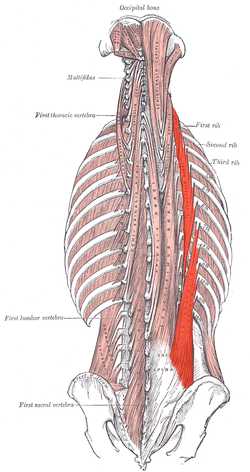Iliocostalis Lumborum
Original Editor - Oyemi Sillo
Lead Editors - Vidya Acharya, Oyemi Sillo, Kim Jackson, Abbey Wright, Lucinda hampton, Evan Thomas, WikiSysop and 127.0.0.1
Description[edit | edit source]
Iliocostalis Lumborum belongs to the lateral column of the Sacrospinalis group of muscles.[1] It is the most inferior and lateral of the erector spinae muscles.[2]
Anatomy[edit | edit source]
Origin[edit | edit source]
Anterior surface of a broad and thick tendon w attached to the medial crest of sacrum, spinous processes of the lumbar vertebrae, 11th and 12th thoracic vertebrae, posterior part of the medial lip of iliac crest, supra-spinous ligament and the lateral crest of sacrum[3].
Insertion[edit | edit source]
By tendons into inferior borders of the angles of the lower 6 or 7 ribs[3][4]
Nerve Supply[edit | edit source]
Dorsal rami of thoracic and lumbar spinal nerves (T7 to L3)[5]
Blood Supply[edit | edit source]
Dorsal branches of the lumbar arteries from the aorta. Dorsal branches of the lateral sacral artery from the internal iliac artery.[5]
Muscle Fibre[edit | edit source]
Characterised by Type 1 muscle fibre, indicating the tonic holding and stabilisation function.[6]
Action[edit | edit source]
- Extension of Spine: Acting bilaterally, extension and hyperextension of the spine. Acting unilaterally, laterally flexes the spine[4]
- Respiration: It assists as an accessory muscle of expiration, due to its insertion on the ribs[7]
- Stabilization of Spine: Iliocostalis lumborum along with multifidus contribute to support and control the orientation of lumbar spine.[6]
Clinical Relevance:[edit | edit source]
Low back pain[edit | edit source]
Pisa syndrome:[edit | edit source]
Pisa Syndrome [8]is defined as a reversible lateral bending of the trunk with a tendency to lean to one side. It is a frequent and often disabling complication of Parkinson's disease. As some forms of Pisa syndrome are potentially reversible, there is growing consensus on the importance of its early recognition and the importance of pharmacological adjustment and rehabilitation.[9]
Assessment[3][edit | edit source]
Power[edit | edit source]
Position: Prone with hands clasped behind buttocks or head.
Fixation: Examiner must stabilize the legs firmly on the table.
Test: Trunk extension
Pressure: If performed with hands behind back no pressure is needed.
Weakness[edit | edit source]
Bilateral weakness of low back muscles results in a lumbar kyphosis and increased thoracic kyphosis.
Unilateral weakness results in lateral curvature with convexity towards the weak side.
Length[edit | edit source]
Bilateral contracture of low back muscles results in lordosis.
Unilateral contracture results in scoliosis with convexity to the opposite side.
Treatment[edit | edit source]
Strengthening[edit | edit source]
References[edit | edit source]
- ↑ Gray, Henry. Anatomy of the Human Body. Philadelphia: Lea & Febiger, 1918; Bartleby.com, 2000. www.bartleby.com/107/.
- ↑ Muscles That Influence the Spine; Barclay W. Bakkum, Gregory D. Cramer, in Clinical Anatomy of the Spine, Spinal Cord, and Ans (Third Edition), 2014 https://www.sciencedirect.com/topics/neuroscience/iliocostalis
- ↑ 3.0 3.1 3.2 Muscle Testing and Function;4th Edition; Kendall, McCreary, Provance; Page No.138.
- ↑ 4.0 4.1 http://www.wheelessonline.com/ortho/iliocostalis_lumborum_1
- ↑ 5.0 5.1 http://www.anatomyexpert.com/app/structure/5243/
- ↑ 6.0 6.1 Therapeutic Exercise for Spine Segmental Stabilization in Low Back Pain; Richardson, Jull, Hodges, Hides; Scientific Basis; Page No.24.
- ↑ Muscles Testing and Function;4th Edition; Kendall, McCreary, Provance; Accessory Muscles of Respiration, Page No.330.
- ↑ Barone P, Santangelo G, Amboni M, Pellecchia MT, Vitale C. Pisa syndrome in Parkinson's disease and parkinsonism: clinical features, pathophysiology, and treatment. The Lancet Neurology. 2016 Sep 1;15(10):1063-74.https://www.ncbi.nlm.nih.gov/pubmed/27571158
- ↑ Tinazzi M, Geroin C, Gandolfi M, Smania N, Tamburin S, Morgante F, Fasano A. Pisa syndrome in Parkinson's disease: An integrated approach from pathophysiology to management. Movement Disorders. 2016 Dec 1;31(12):1785-95.https://www.ncbi.nlm.nih.gov/pubmed/27779784







